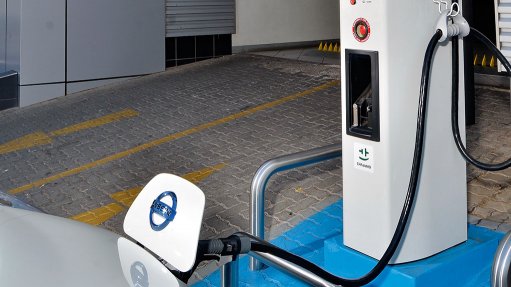
CHARGE IT A Leaf charging station at a Nissan dealership
Photo by: Nissan
Sales of electric cars should pick up as more of such vehicles become available on the South African market, says Nissan South Africa (SA) chief marketing manager Ross Garvie.
The local arm of the Japanese car company launched the country’s first fully electric vehicle (EV) in November.
It is expected that the Nissan Leaf will be followed by the Volkswagen electric Golf and the BMW i3 next year.
Garvie does not want to “place a peg in the ground” as to how many Leafs Nissan SA will sell, saying only that the company will be able to cater for demand.
Government, corporates, the taxi-cab and rental markets and environmentally conscious individuals are expected to make up the bulk of Leaf buyers.
The Leaf sells for R446 000, with electricity to charge the vehicle to its full range of 195 km over a six-year period costing R22 500, says Garvie. Maintenance costs over the same period, outside the 90 000 km/3-year service plan and 100 000 km/3-year warranty (which includes the lithium-ion battery), are set at R1 500. (The battery makes up 40% of the vehicle’s production cost.)
As there is no internal combustion engine, which means no fluids, such as oil, and components such as spark plugs, maintenance costs are much less, compared with a standard vehicle, he adds.
Service intervals are 15 000 km, or once a year.
Insurance costs on the Leaf will also typi-cally be less than other cars, says Garvie, as the profile of the typical Leaf driver is that of a less risky driver, living in a more upscale area where there is a smaller risk of theft.
“[Any hijacker] can also only go 200 km before the vehicle would need recharging,” quips Garvie.
The total cost of mobility for the Leaf over six years will be R470 000, he adds, compared with R484 000 for a petrol vehicle of the same size and capacity, and R505 000 for a hybrid.
There is no government tax break or other incentive to buy the Leaf, as is the case in most countries where EVs have been rolled out.
Trade and Industry Minister Dr Rob Davies said earlier this year that his department would present a South African EV roadmap, which places emphasis on local manufacture, to Cabinet for approval before the end of next year.
The roadmap will include standards for the industry and place emphasis on government’s acquisition of EVs.
Phased Approach
As the Leaf is new technology introduced to the local market, the first phase of the vehicle’s roll-out will be in Gauteng only, with sales at seven dealerships in Pretoria and Johan-nesburg.
“We want to start small and grow organic-ally. We have no illusions about this being a volume seller. We will try and establish the credibility of electric vehicles first,” says Garvie.
Charging stations in the first phase will be available at Nissan dealerships, with a smart phone app advising Leaf owners where the nearest charging station is located.
Charging at home, typically overnight, takes seven hours from empty, with a quick charge at dealers taking 15 to 20 minutes to reach 80% capacity.
The second phase of the Leaf’s roll-out will be in Durban and Cape Town next year, moving dealers selling the EV to between 10 and 15.
A pilot project with energy provider Eskom has already been rolled out, with the potential impact on the national grid negligible.
The question around electricity supply for EV mobility has become pertinent as Eskom recently declared an electricity emergency, with the country’s energy demand exceeding supply.
“You would need 10 000 to 20 000 EVs in one area, such as Sandton, to have an impact on the grid,” notes Garvie. “And we won’t get there in the next ten years.”
As with the lack of incentives, government is also not providing charging infrastructure.
However, says Garvie, local vehicle manu-facturers are negotiating with government on charging infrastructure roll-out incentives.
“We are waiting for a third party to come out here and say this is a good business opportunity. The EV industry would depend on that.”
Garvie says Nissan is in talks with an interested party on this matter.
Nissan is also looking at locating a local partner that will provide a second life to the Leaf’s battery once it comes to an end, at around ten years.
After this period, it should, however, still be able to operate at 80% capacity, finding use in many other applications, says Garvie.
He adds that Nissan will be able to buy the battery from Leaf owners at the end of its life, and then sell it on to a third party.
Engineering News Drives the Leaf
Driving the Leaf for short distances of 20 km to 30 km does not create the much-dreaded range anxiety associated with EVs.
In Eco mode, the vehicle steadily and predic- tably counts the kilometres down to recharging.
The Leaf is big and spacious enough to seat five adults, with a generous boot for sports bags and other luggage that come with having a family.
The drive is comfortable, with the Leaf equipped with most modern luxuries drivers have come to expect from a vehicle of its size.
With Eco mode switched off, the Leaf is helluva nippy, and eager to deliver its 254 Nm of torque.
However, watch the range in normal mode if you are heavy on the accelerator, and also on the highway. The Leaf is ultimately best suited to city driving.
Driving the Leaf well ‘rewards’ the driver with the building of a small, electronic tree in the instrument cluster, with leafs continuously added for eco-minded driving.
Launched in late 2010, the Leaf has sold 87 000 units worldwide and travelled around 500 000 km with zero tailpipe emissions in the process.
In October alone, 10 000 units were sold.